Yes, cougars have been sighted in Door County. However, Door County likely has no resident cougars, and cougars that have been sighted are likely transient.
This article delves into the rare and transient world of cougars, shedding light on their sightings, characteristics, and behaviors. Join us as we uncover the captivating details about these majestic creatures, their role in the ecosystem, and the intriguing factors that make their visits to Door County a truly special event.
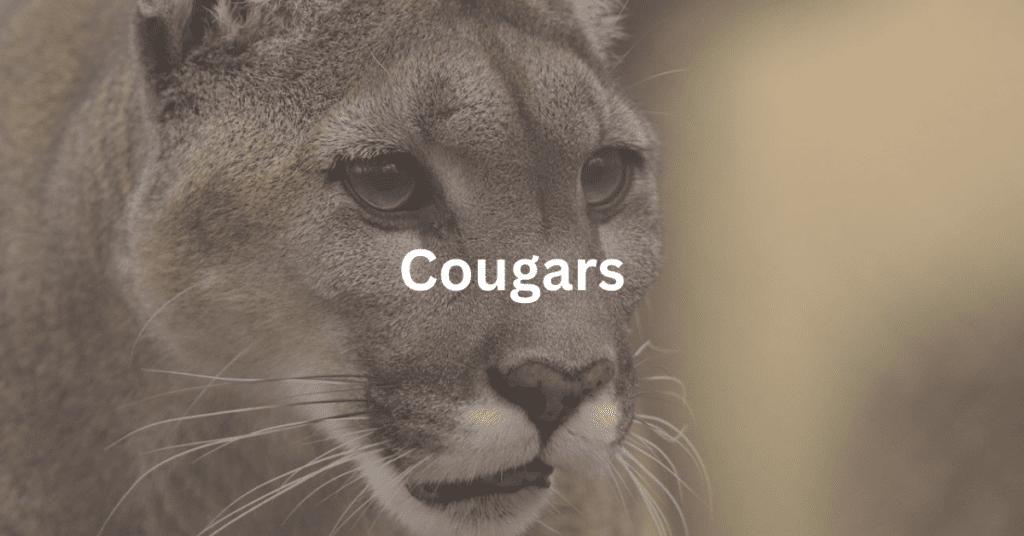
Cougar Sightings in Door County
Cougars have been spotted in the Door County area, albeit their appearances are few and far between. These majestic creatures are not permanent residents; rather, they’re transient visitors that occasionally grace the county with their presence.
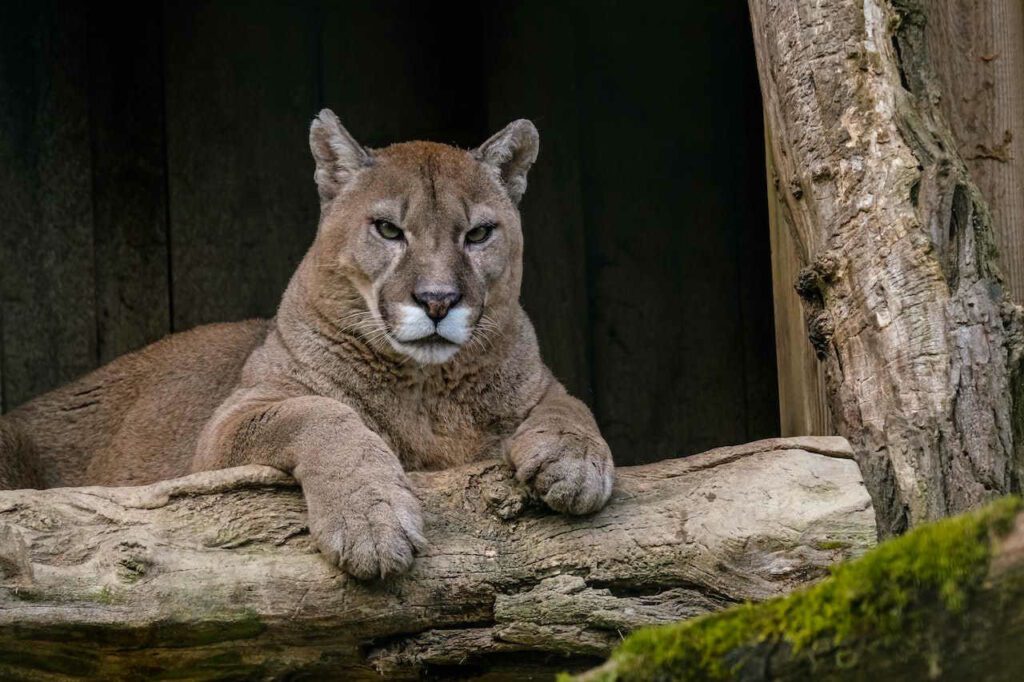
According to data from the Wisconsin Department of Natural Resources (DNR), there was a sighting of a cougar in 2022 in Door County that qualifies either as “confirmed” or “probable.” This confirms that these elusive felines do make their way into the region. But the encounters are so infrequent that they only serve to emphasize the special nature of these moments.
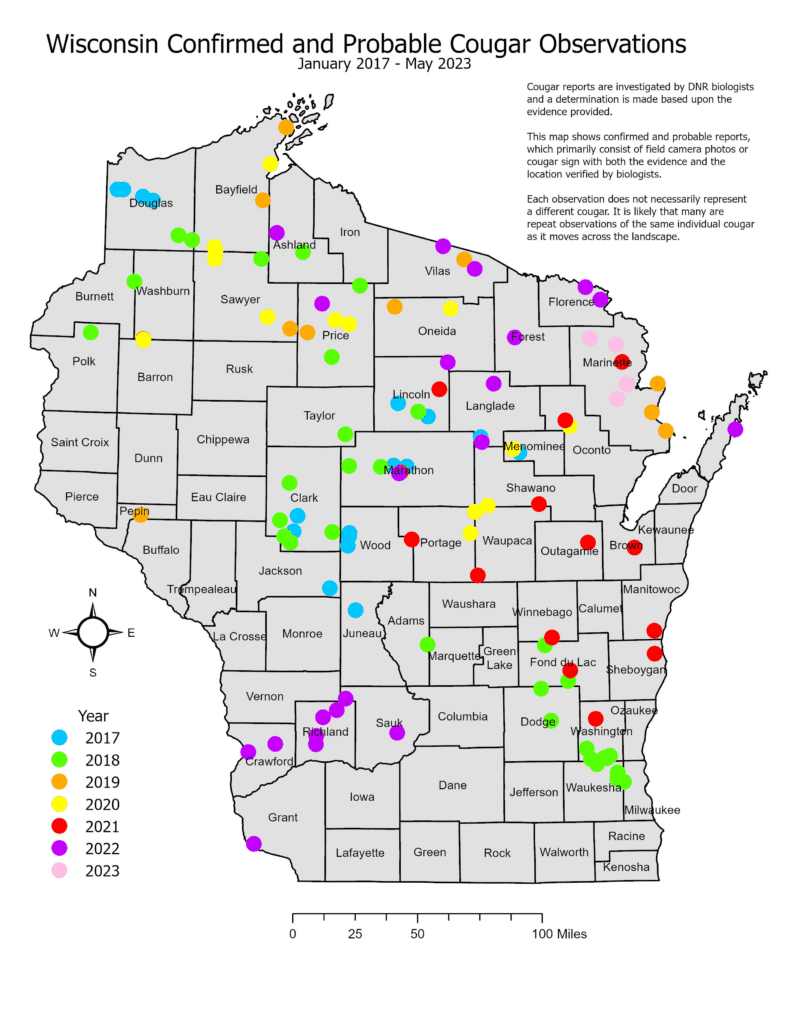
Notably, there was a cluster of reports in 2003 about a potential cougar sighting in Door County. However, despite the stories, no concrete evidence such as photographs, tracks, or scat was found to substantiate these claims. This highlights the importance of verifying such sightings through tangible evidence to gain a clearer understanding of the local wildlife.
While Door County itself might not be a hotspot for cougar activity, neighboring Marinette County has experienced a higher number of reported cougar sightings.
One way to track cougar sightings in Wisconsin in real-time is through the Snapshot Wisconsin program.
Transient Nature of Cougars in Door County
Cougars, also known as mountain lions or pumas, possess a remarkable ability to cover vast distances. In fact, these enigmatic creatures are known to traverse incredible spans, occasionally crossing the entire North American continent.

A fascinating example of this is the journey of a cougar that made its way from South Dakota, through Wisconsin, and eventually was killed in Connecticut. This serves as a poignant reminder of their far-ranging movements and adaptability to different landscapes.
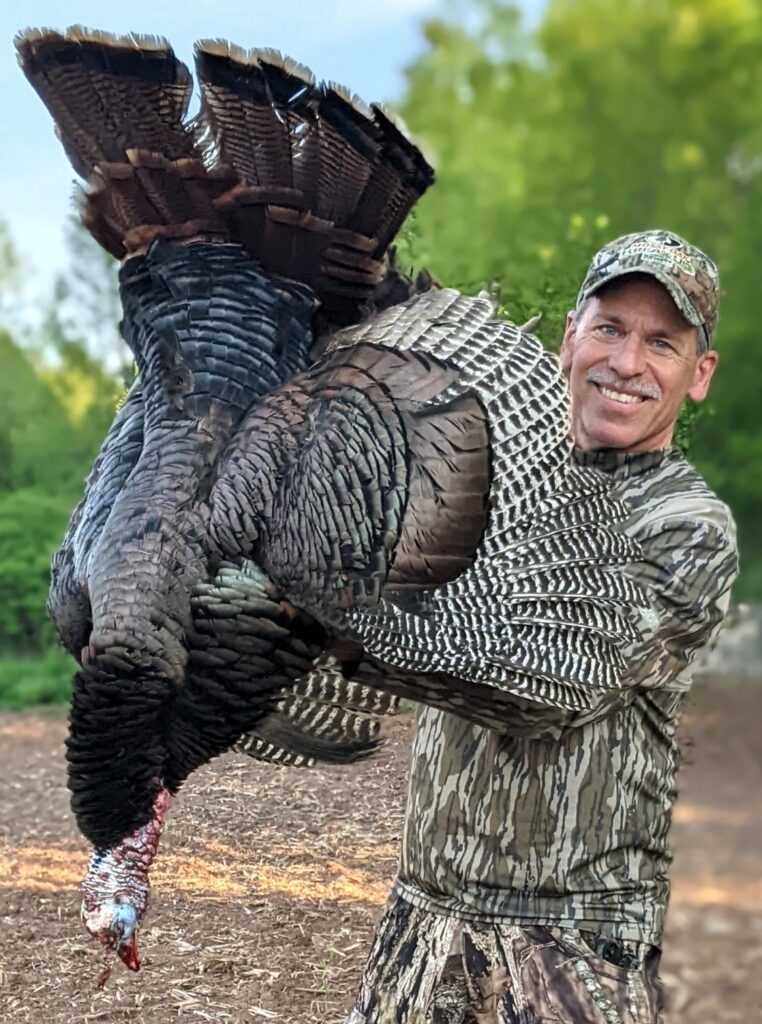
One of the interesting patterns observed among wandering cougars is the prevalence of juvenile males in these exploratory journeys. Young male cougars, in particular, are often driven by the instinct to seek out new territories and potential mates. These solo voyages can take them across diverse habitats in their quest to establish their own territories and find suitable partners for mating.
As local wildlife expert Kevin Naze says, such animals are “looking for love in all the wrong places.”

Steven Burns, Game Species Manager for the Wisconsin Department of Natural Resources, notes that cougars are rare in Wisconsin and especially in Door County. “Mountain lion sightings are still relatively rare in Wisconsin- even more so in Door County due to its isolated geography. However, each year the DNR tracks confirmed and probable sightings throughout the state. Many reports of Mountain lions are case of mistaken identification. Similar to wolves in Door County, Mountain Lions in WI are assumed to be juvenile males. It’s likely these animals are dispersing from established populations (likely in the Black Hills of South Dakota). Bobcat are the only wild cat species known to breed in the wild in Wisconsin.”
Characteristics of Cougars: Masters of Stealth and Adaptation
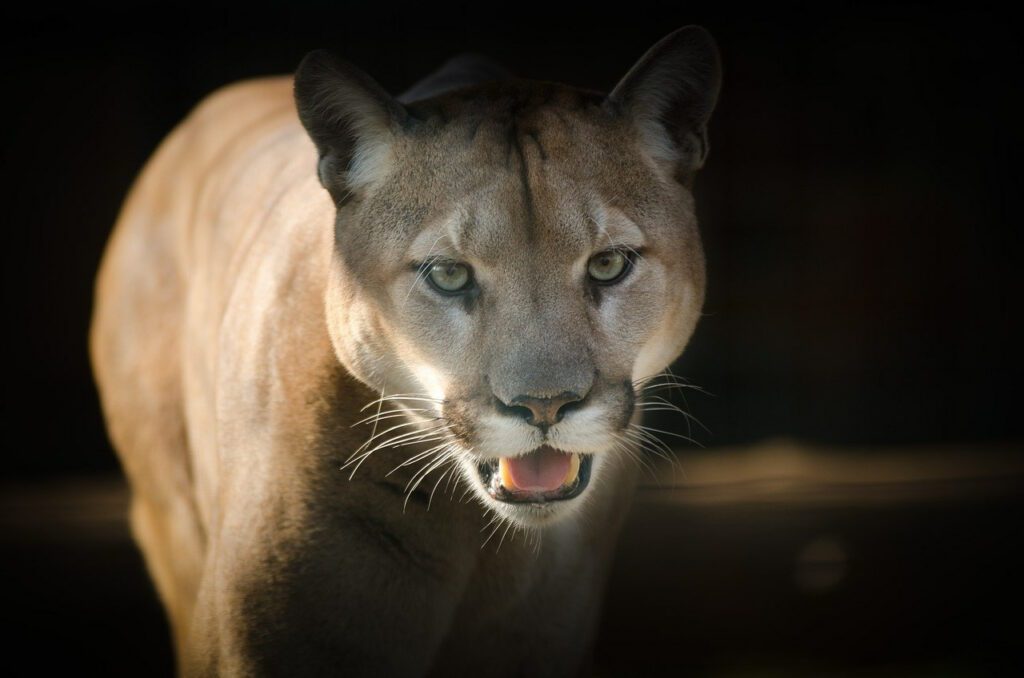
Cougars, with their distinct features and awe-inspiring capabilities, hold a unique place in the natural world. Let’s delve into some of the remarkable characteristics that define these elusive predators:
Size and Appearance
Cougars are sizable cats, with adult males typically weighing between 130 to 220 pounds and measuring around 7 to 8 feet in length, including their tails. Females are generally smaller, weighing around 85 to 135 pounds. Their tawny-colored fur, often referred to as “tawny” or “fawn,” helps them blend seamlessly into their surroundings, enhancing their stealth during hunts.
Other Identifying Physical Characteristics
One of the key features that set cougars apart is their long, muscular bodies and powerful legs, enabling them to pounce and chase with agility. Their distinctive cat-like face, with a strong jaw and keen eyesight, aids in their hunting prowess. Additionally, cougars possess sharp retractable claws and powerful jaws, perfectly adapted for capturing and consuming prey.
Diet and Hunting Methods
Cougars are skilled hunters that primarily feed on deer, but their diet can also include smaller mammals like raccoons, rabbits, and rodents. Their hunting technique is marked by stealth and patience. They often stalk their prey, getting as close as possible before launching a rapid and powerful attack. Their strong bite, targeting the neck or throat, usually results in a swift and efficient kill.
Breeding Season and Reproduction
Cougars do not have a strict breeding season; they can reproduce throughout the year. The females, or “queens,” raise their cubs alone. After a gestation period of about 90 days, a litter of typically one to six kittens is born. The cubs stay with their mother for about a year and a half, during which time they learn essential hunting and survival skills.
Other Habits
Cougars are solitary creatures, known for their preference to roam and establish their own territories. They are highly adaptable and can thrive in various habitats, from forests and mountains to deserts and swamps. These territorial tendencies contribute to their transient behavior, as young males venture out to find new territories and mates.
Why Cougar Sightings are Rare in Door County
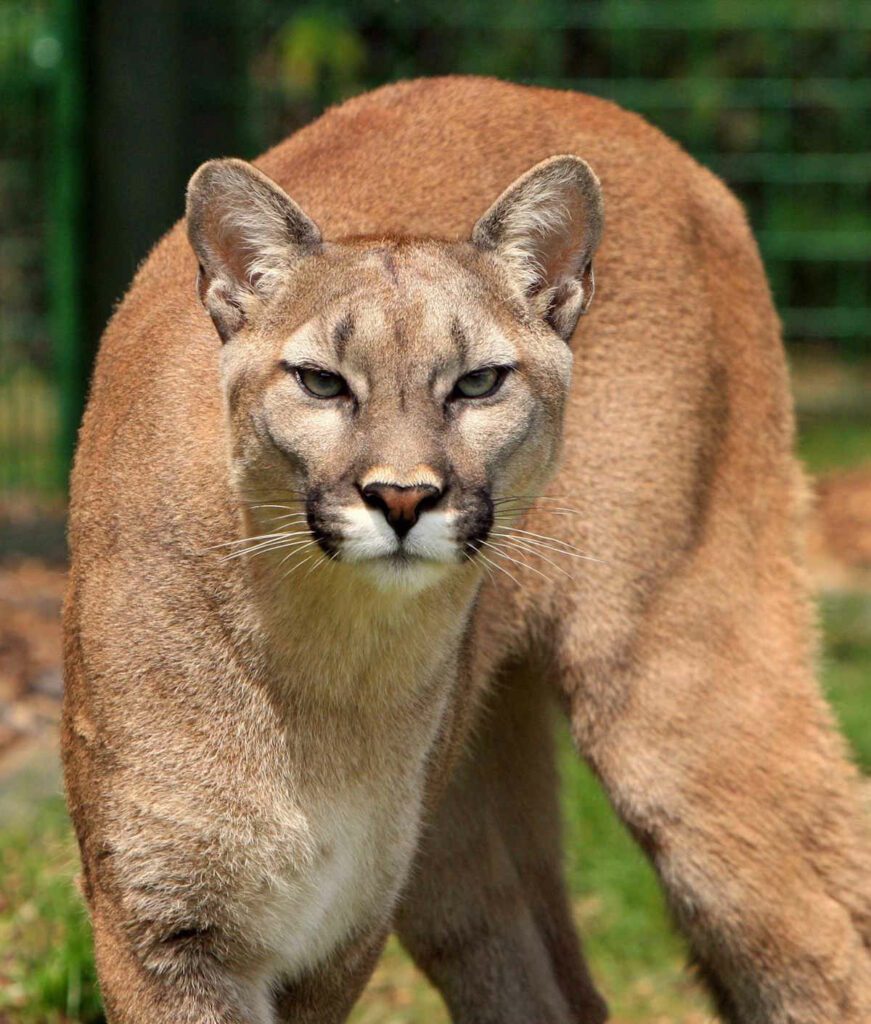
While cougars may have been spotted in the Door County area on occasion, their presence remains a rarity. Several factors contribute to the infrequency of cougar sightings in this region:
Geographical Isolation
Door County is distinctively situated, isolated from the mainland of Wisconsin by the expansive bay of Green Bay. This geographical barrier naturally limits the movement of animals between the county and the mainland. As a result, cougars are less likely to wander into Door County compared to areas with easier access.
Ample Cover and Habitat
Door County boasts a landscape rich in natural cover, including dense forests, thick undergrowth, and varied terrain. This abundance of habitat provides cougars with ample places to hide, making them difficult to spot. Their ability to blend into their surroundings, combined with the cover provided by the county’s diverse vegetation, contributes to their elusiveness.
Elusive Nature of Cougars
Cougars are renowned for their elusive behavior. They are naturally solitary creatures, tending to avoid human presence whenever possible. This shyness and instinct to remain hidden make direct encounters with cougars a rare occurrence. Their preference for remote and undisturbed areas further reduces the likelihood of human interactions, contributing to the scarcity of sightings.
Alternative Names for Cougars
Cougars are known by various names across different regions and cultures, each reflecting a unique aspect of their character and habitat. Here’s a diverse collection of alternative names for these majestic cats:
- Mountain Lion: This common moniker reflects their affinity for mountainous and rugged terrains.
- Puma: Originating from the Quechua language, “puma” emphasizes the strength and power of these predators.
- Panther: Often used interchangeably with “cougar,” this name alludes to their dark fur color variation, known as “melanism.”
- Catamount: A term that harks back to the early American settlers, underscoring their feline nature.
- Screamer: This name captures their distinctive vocalizations, which range from growls to high-pitched cries.
- Ghost Cat: Highlighting their elusive behavior and ability to vanish into their surroundings.
- Deer Tiger: Reflecting their role as apex predators preying on deer and their cat-like appearance.
- Florida Panther: A specific term for the subspecies found in the southeastern United States, emphasizing their presence in the state of Florida.
- Silver Lion: Used to describe cougars with a silvery-gray coat, giving them a regal appearance.
- Shadow Cat: Signifying their ability to remain concealed and stealthy in their hunting and movement.
- Red Tiger: Referring to the reddish or tawny color of their fur.
- Cougarundi: A term used in some Latin American countries, emphasizing their cougar-like characteristics.
- Mexican Lion: A name attributed to them due to their presence in Mexico and their resemblance to lions.
- Rock Lion: Highlighting their habitat preference for rocky terrain and mountainous regions.
- Wildcat: This generic term describes their status as wild and untamed felines.
- Gray Ghost: Reflecting their muted coloration and elusive behavior, making them akin to phantoms in the wild.
- Swamp Lion: Emphasizing their adaptability to different ecosystems, including swamps and wetlands.
- Cabeza de Viejo: A name used in some Spanish-speaking regions, meaning “old man’s head,” referring to the appearance of their skull.
- Mountain Screamer: Combining their affinity for mountain habitats with their distinctive vocalizations.
- Ghost Rider: Alluding to their stealthy and solitary nature, as if they are riding the wind through the wilderness.
These diverse alternative names showcase the range of perceptions and characteristics associated with cougars, adding to the allure and mystique of these captivating creatures.
Can You Hunt Cougars in Door County?
If you’ve ever wondered whether hunting cougars is permitted in Door County, the answer is a straightforward “no.” The State of Wisconsin has set clear regulations regarding cougar hunting, and these regulations extend to Door County as well.
As of now, cougar hunting is not allowed in the State of Wisconsin. Cougars are classified as a protected species, and their populations are closely monitored and managed by wildlife authorities. This protection extends to Door County and the entire state, ensuring that these elusive predators are safeguarded and allowed to maintain their presence in the local ecosystems.
The decision to prohibit cougar hunting reflects a commitment to conservation efforts and the preservation of biodiversity. By implementing such regulations, Wisconsin aims to maintain a balance between human activities and the natural world, recognizing the vital role that cougars play in the ecological dynamics of the region.
Distinguishing Cougars, Bobcats, and Housecats: Spotting the Differences
When it comes to wildcats, distinguishing between different species can be a challenge, especially when their sizes and appearances may overlap. Let’s take a closer look at how to tell apart cougars, bobcats, and our domestic companions, housecats:
Cougars
- Size Matters: Cougars are significantly larger than both bobcats and housecats. Adult cougars can weigh up to 220 pounds or more and measure around 7 to 8 feet in length, including their tail.
- Distinctive Tail: Cougars have a long, cylindrical tail with a black tip, and it usually measures about one-third of their body length. This tail is an important balance and communication tool for these big cats.
- Tawny Coat: Their fur is typically tawny or fawn-colored, helping them blend into their surroundings. Darker individuals with melanism can also occur.
- Powerful Build: Cougars have a strong, muscular build and are known for their powerful legs and jaws. Their faces are more rounded compared to the more angular faces of bobcats.
Bobcats
- Smaller Size: Bobcats are smaller than cougars but larger than most housecats. They generally weigh between 15 to 35 pounds and have a body length of about 2 to 3 feet.
- Distinctive Ears and Tail: Bobcats have tufted ears and a short, “bobbed” tail, which sets them apart from both cougars and housecats.
- Spotted Fur: Their fur is often characterized by spots or blotches, providing them with excellent camouflage in their natural habitats.
- Facial Features: Bobcats have a more defined facial structure, including prominent cheek ruffs and a distinctively patterned coat.
Housecats
- Size and Proportion: Housecats are considerably smaller than both cougars and bobcats. Their sizes can vary widely, but on average, they weigh around 8 to 10 pounds and have a length of 18 to 20 inches.
- Tail and Ears: Housecats have a variety of tail lengths and ear shapes, but they lack the distinct features of bobcats’ tufted ears and cougars’ long tails.
- Domestic Traits: Housecats come in a wide range of coat colors and patterns due to domestication. Their behavior and vocalizations also differ from wildcats.
While telling these wildcats apart might be tricky, looking for key features like size, tail length, ear tufts, and coat patterns can help you correctly identify whether you’re looking at a cougar, a bobcat, or a familiar housecat. Remember, when encountering wildcats in the wild, it’s important to maintain a safe distance and respect their space to ensure both your safety and their well-being.
Frequently Asked Questions
While rare, cougar attacks on humans can occur. These predators generally avoid people, but if encountered, it’s best to stay calm, avoid eye contact, and slowly back away.
No, cougars are not suitable as pets. They’re wild predators with specific needs and behaviors that are not compatible with domestic life.
Yes, cougars can roar, but their roars are less thunderous than those of lions. They also produce other vocalizations, such as growls, screams, and purrs.
Summary: Cougars in Door County
- Cougars are indeed seen in Door County but are rare and transient visitors.
- A confirmed sighting occurred in 2022, with an unconfirmed cluster in 2003.
- Cougars can cover vast distances and are often juvenile males searching for mates.
- They’re also known as mountain lions, pumas, or panthers.
- Cougars have tawny fur, strong jaws, and retractable claws.
- Their diet includes deer, and they employ stealthy hunting techniques.
- Cubs stay with their mothers for about a year and a half.
- Door County’s ample cover and their elusive nature contribute to rare sightings.
- Cougar hunting is not allowed in Wisconsin, protecting the species.
- Distinguishing cougars from bobcats and housecats requires attention to size, features, and behavior.
